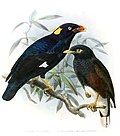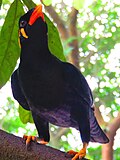This article needs additional citations for verification .(November 2021) |
| Gracula | |
|---|---|
 | |
| Diversity and distribution within the genus | |
| Scientific classification | |
| Kingdom: | Animalia |
| Phylum: | Chordata |
| Class: | Aves |
| Order: | Passeriformes |
| Family: | Sturnidae |
| Genus: | Gracula Linnaeus, 1758 |
| Type species | |
| Gracula religiosa Linnaeus, 1758 | |
| Diversity | |
| See text | |
| Synonyms | |
| |
Gracula is a genus of mynas, tropical members of the starling family of birds found in southern Asia and introduced to Florida in the United States.



